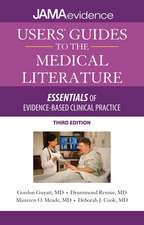Users' Guides to the Medical Literature: A Manual for Evidence-Based Clinical Practice, 3E
Autor Gordon Guyatten Limba Engleză Paperback – 16 feb 2015
- Revised and updated to reflect the latest in medical research and evidence-based resources
- Practical focus and organization to guide clinicians through the fundamentals of using the medical literature to the more advanced strategies and skills for use in patient care, using the key questions to assess any new research:
- What are the results?
- How serious is the risk of bias?
- How do I apply the results to patient care?
- Updated real-world examples drawn from the medical literature
- New chapters that reflect the changing complexity of medical research and literature, including genetic association studies, systematic reviews and meta-analyses, network meta-analysis, noninferiority trials, quality improvement, and evidence-based medicine and the theory of knowledge
- New emphasis on understanding the role of patient preferences and preappraised resources that provide updated evidence and evidence-based recommendations for practice
Preț: 451.82 lei
Preț vechi: 647.57 lei
-30% Nou
Puncte Express: 678
Preț estimativ în valută:
86.45€ • 90.51$ • 71.54£
86.45€ • 90.51$ • 71.54£
Carte tipărită la comandă
Livrare economică 04-15 aprilie
Livrare express 28 februarie-06 martie pentru 221.86 lei
Preluare comenzi: 021 569.72.76
Specificații
ISBN-13: 9780071790710
ISBN-10: 0071790713
Pagini: 736
Dimensiuni: 183 x 231 x 28 mm
Greutate: 1.04 kg
Ediția:3. Auflage.
Editura: McGraw Hill Education
Colecția McGraw Hill / Medical
Locul publicării:United States
ISBN-10: 0071790713
Pagini: 736
Dimensiuni: 183 x 231 x 28 mm
Greutate: 1.04 kg
Ediția:3. Auflage.
Editura: McGraw Hill Education
Colecția McGraw Hill / Medical
Locul publicării:United States
Cuprins
Foreword
Preface
The Foundations
1 How to Use the Medical Literature—and This Book—to Improve Your Patient Care
2 What Is Evidence-Based Medicine?
3 Evidence-Based Medicine and the Theory of Knowledge
4 What Is the Question?
5 Finding Current Best Evidence
6 Why Study Results Mislead: Bias and Random Error
Therapy
7 Therapy (Randomized Trials)
8 How to Use a Noninferiority Trial
9 Does Treatment Lower Risk? Understanding the Results
10 Confidence Intervals: Was the Single Study or Meta-analysis Large Enough?
11 Advanced Topics in the Risk of Bias of Therapy Trials
11.1 An Illustration of Bias and Random Error
11.2 Surprising Results of Randomized Trials
11.3 Randomized Trials Stopped Early for Benefit
11.4 The Principle of Intention to Treat and Ambiguous Dropouts
11.5 N-of-1 Randomized Clinical Trials
11.6 Clinical Decision Support Systems
11.7 How to Use an Article About Quality Improvement
12 Advanced Topics in the Results of Therapy Trials
12.1 Hypothesis Testing
12.2 Understanding the Results: More About Odds Ratios
12.3 What Determines the Width of the Confidence Interval?
12.4 Composite End Points
12.5 Measuring Patients’ Experience
13 Advanced Topics in Applying the Results of Therapy Trials
13.1 Applying Results to Individual Patients
13.2 Numbers Needed to Treat
13.3 Misleading Presentations of Clinical Trial Results
13.4 Surrogate Outcomes
13.5 Qualitative Research
Harm (Observational Studies)
14 Harm (Observational Studies)
15 Advanced Topics in Harm
15.1 Correlation and Regression
Diagnosis
16 The Process of Diagnosis
17 Differential Diagnosis
18 Diagnostic Tests
19 Advanced Topics in Diagnosis
19.1 Spectrum Bias
19.2 Examples of Likelihood Ratios
19.3 Measuring Agreement Beyond Chance
19.4 Clinical Prediction Rules
Prognosis
20 Prognosis
21 Advanced Topics in Prognosis
21.1 How to Use an Article About Genetic Association
Summarizing the Evidence
22 The Process of a Systematic Review and Meta-analysis
23 Understanding and Applying the Results of a Systematic Review and Meta-analysis
24 Network Meta-analysis
25 Advanced Topics in Systematic Reviews
25.1 Fixed-Effects and Random-Effects Models
25.2 How to Use a Subgroup Analysis
Moving From Evidence to Action
26 How to Use a Patient Management Recommendation: Clinical Practice Guidelines and Decision Analyses
27 Decision Making and the Patient
28 Advanced Topics in Moving From Evidence to Action
28.1 Assessing the Strength of Recommendations: The GRADE Approach
28.2 Economic Analysis
28.3 Recommendations About Screening
28.4 Understanding Class Effects
28.5 Evidence-Based Practitioners and Evidence-Based Care
29 Teachers’ Guides to the Users’ Guides
Glossary
Index
Preface
The Foundations
1 How to Use the Medical Literature—and This Book—to Improve Your Patient Care
2 What Is Evidence-Based Medicine?
3 Evidence-Based Medicine and the Theory of Knowledge
4 What Is the Question?
5 Finding Current Best Evidence
6 Why Study Results Mislead: Bias and Random Error
Therapy
7 Therapy (Randomized Trials)
8 How to Use a Noninferiority Trial
9 Does Treatment Lower Risk? Understanding the Results
10 Confidence Intervals: Was the Single Study or Meta-analysis Large Enough?
11 Advanced Topics in the Risk of Bias of Therapy Trials
11.1 An Illustration of Bias and Random Error
11.2 Surprising Results of Randomized Trials
11.3 Randomized Trials Stopped Early for Benefit
11.4 The Principle of Intention to Treat and Ambiguous Dropouts
11.5 N-of-1 Randomized Clinical Trials
11.6 Clinical Decision Support Systems
11.7 How to Use an Article About Quality Improvement
12 Advanced Topics in the Results of Therapy Trials
12.1 Hypothesis Testing
12.2 Understanding the Results: More About Odds Ratios
12.3 What Determines the Width of the Confidence Interval?
12.4 Composite End Points
12.5 Measuring Patients’ Experience
13 Advanced Topics in Applying the Results of Therapy Trials
13.1 Applying Results to Individual Patients
13.2 Numbers Needed to Treat
13.3 Misleading Presentations of Clinical Trial Results
13.4 Surrogate Outcomes
13.5 Qualitative Research
Harm (Observational Studies)
14 Harm (Observational Studies)
15 Advanced Topics in Harm
15.1 Correlation and Regression
Diagnosis
16 The Process of Diagnosis
17 Differential Diagnosis
18 Diagnostic Tests
19 Advanced Topics in Diagnosis
19.1 Spectrum Bias
19.2 Examples of Likelihood Ratios
19.3 Measuring Agreement Beyond Chance
19.4 Clinical Prediction Rules
Prognosis
20 Prognosis
21 Advanced Topics in Prognosis
21.1 How to Use an Article About Genetic Association
Summarizing the Evidence
22 The Process of a Systematic Review and Meta-analysis
23 Understanding and Applying the Results of a Systematic Review and Meta-analysis
24 Network Meta-analysis
25 Advanced Topics in Systematic Reviews
25.1 Fixed-Effects and Random-Effects Models
25.2 How to Use a Subgroup Analysis
Moving From Evidence to Action
26 How to Use a Patient Management Recommendation: Clinical Practice Guidelines and Decision Analyses
27 Decision Making and the Patient
28 Advanced Topics in Moving From Evidence to Action
28.1 Assessing the Strength of Recommendations: The GRADE Approach
28.2 Economic Analysis
28.3 Recommendations About Screening
28.4 Understanding Class Effects
28.5 Evidence-Based Practitioners and Evidence-Based Care
29 Teachers’ Guides to the Users’ Guides
Glossary
Index



















